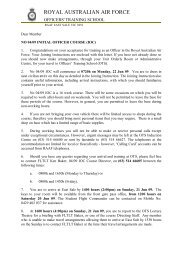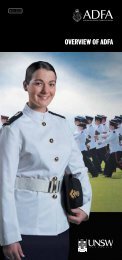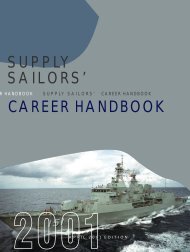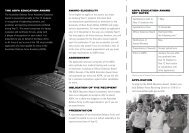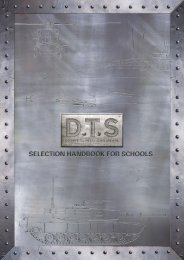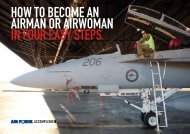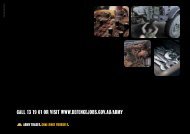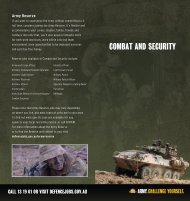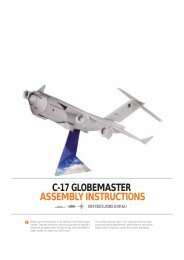AIRFIELD DEFENCE GUARD - Australian Defence Force Recruiting
AIRFIELD DEFENCE GUARD - Australian Defence Force Recruiting
AIRFIELD DEFENCE GUARD - Australian Defence Force Recruiting
- No tags were found...
Create successful ePaper yourself
Turn your PDF publications into a flip-book with our unique Google optimized e-Paper software.
ADG SniperAn Airfield <strong>Defence</strong> Guard sniper is a highly trained airmancapable of undertaking specialist tasks, such as surveillanceand reporting. They must maintain a very high standard offieldcraft and marksmanship.ADG Assault PioneerAirfield <strong>Defence</strong> Guard Assault Pioneers are cross-trained inbasic engineering skills, including the construction of fielddefences, obstacles and the operation of plant equipment.ADG SignallerAirfield <strong>Defence</strong> Guard sections have at least one signaller.A signaller provides communications to enable highlydynamic, responsive command and control.ADG Close PersonalProtection OperatorAs an Airfield <strong>Defence</strong> Guard you may have the opportunityto become qualified as a Close Personal Protection Operator(CPPOP). CPPOP’s ensure the protection of VIPs and aircrew.ADG Aircraft SecurityOperationsAs an Airfield <strong>Defence</strong> Guard you will be trained in AircraftSecurity Operations (ASO). The purpose of Aircraft SecurityOperations is to provide full force protection to aircraft,aircrew, evacuees and essential equipment, both in flightand on the ground within the confines of an airfield.ADG Patrol and SurveillanceOperationsAirfields are highly vulnerable to reconnaissance and attack.Airfield <strong>Defence</strong> Guards are trained to conduct Patrol andSurveillance Operations (PSO) around potential approachesto airfields, thus providing early warning and protection tomilitary assets and personnel.ADG Quick Reaction <strong>Force</strong>As an Airfield <strong>Defence</strong> Guard you will be trained to undertakeQuick Reaction <strong>Force</strong> (QRF) duties including: cordons andsearches, clearances, vehicle and personnel checks, andlastly, convoy protection. You will normally operate out of theBushmaster Protected Mobility Vehicle.ADG Urban OperationsA large airfield is best viewed as a small town. Thus, Airfield<strong>Defence</strong> Guards are trained to operate in an urban environment.A typical dayThere is no typical day for an ADG – it’s always changing andthat’s the great thing. On base you have a fairly structured daywith a finishing time that allows you to catch up with friends andfamily, or utilise the sports and recreation facilities available.Most ADG units start the day with a workout, followed by trainingon tactics and techniques to maintain the skills required to behighly effective in combat and non-combat roles. Our instructorskeep it fun and what other job pays to keep you fit?It’s off base though, where the fun really begins. You’ll find allsorts of practical and real challenges that will test your skillsand motivate you both physically and mentally.ADGs regularly participate in Unit, Air <strong>Force</strong>, Joint andCoalition exercises that help validate and enhance yourspecialist skills. These exercises occur several times per year,and range from one to six weeks in duration. This preparesyou for longer deployments within Australia or overseas whereyour daily routine will vary. Here you’ll apply your skills in aneven more challenging environment. ADGs are also on call andTime for funThere’s plenty of time for fun in the Air <strong>Force</strong>. Once you’vefinished for the day you can take off or, if you want, stickaround and take advantage of all the great sports andrecreational facilities open to you. The base is also a greatplace to meet up with your mates and relax over a drink.You’ll make great friends in the Air <strong>Force</strong>. Friends that will lasta lifetime. Even people who’ve only been in the Air <strong>Force</strong> fora few weeks talk about the bond you form with your peers.It’s one of the best parts of Air <strong>Force</strong> life.SalaryUpon completion of your employment training you will receivea salary package of approximately $59,000p.a. ADGs alsoreceive further deployment allowances.Benefits• Free healthcare• Low interest loans• Subsidised accommodation • Guaranteed job security• Up to 18% super• Opportunity to travelInformation is correct at time of printing and is subjectto change. For the latest information call 13 19 01or visit www.defencejobs.com.au/airforceAirfield <strong>Defence</strong> GuardThe bodyguard for a 20-ton weaponmay be required to deploy at short notice.MDFF1154 07/09
What is an Airfield<strong>Defence</strong> Guard?An Airfield <strong>Defence</strong> Guard isn’t just a security detail. In many waysit’s our nation’s last line of defence against a hostile invader.Airfield <strong>Defence</strong> Guards (ADGs) are highly trained to deal withall sorts of situations; from assisting with natural disasters rightthrough to infantry assault and rocket attacks.They provide the specialist ground defence force required toprotect air power assets from the effects of hostile action inand around Air <strong>Force</strong> Bases both in Australia and overseas.They form the backbone of the Air <strong>Force</strong>’s ground combatforce; protecting infrastructure and personnel against attack byenemy ground forces a number of kilometres from the airfieldperimeter. They also instruct other Air <strong>Force</strong> personnel inrelevant ground defence techniques.ADGs live and work as a team, normally in tightly bonded groupsof five to ten men. Some typical tasks performed by ADGs are:vehicle and foot patrols over extended periods in and aroundairfields, and through arduous, vegetated or urban terrain inall extremities of weather by day or night whilst individuallycarrying specified equipment loads to accomplish the mission.operations; man crew served weapons such as machine gunsand anti-armour weaponry and offer instruction on small armssuch as rifles, shotguns and machine guns.An elite groupThe Airfield <strong>Defence</strong> Guards officially began duty during theSecond World War. No 1 Airfield <strong>Defence</strong> Squadron formed atLivingston Airfield in the Northern Territory, on the 7th April1945 and No 2 Airfield <strong>Defence</strong> Squadron formed on the 10thApril 1945 on the island of Morotai.ADGs (then known as Aerodrome <strong>Defence</strong> Guards) provided amobile security detail available for any emergency. The ADGswere responsible for providing the operational air bases inAustralia and in the South Pacific with trained and competentguards that could defend the bases against Japanese attacks.Since the creation of the ADG, Guards have been deployed onactive service throughout many parts of the world, such asAfghanistan, Cambodia, East Timor, Iraq, Vietnam, the SolomonIslands and Thailand. The most recent deployment has been tothe Middle East Area of Operations (MEAO) from 2003.TRAININGOn graduation from 1RTU you will undertake your initialemployment training which is conducted at the RAAFSecurity and Fire School (RAAFSFS), RAAF Base Amberley,QLD. 14.4 weeks duration, the Airfield <strong>Defence</strong> Guard BasicCourse provides students with training on: small armsweapons, high explosive weapons and explosive stores, radiocommunications, field engineering, battle-craft and tactics,map reading and navigation, nuclear, biological and chemicaldefence, first aid and casualty handling.PHYSICAL FITNESSThe basic ADG course is physically very demanding andstudents need to have a very high level of physical fitnessbefore commencing training.Prior to enlistment candidates will be required to obtain aLevel 7.5 on a Beep Test, which measures aerobic capacity.A Beep Test basically means you’ll need to run to and froalong a 20-metre track while keeping up with a series ofbeeps. Candidates are also required to undertake 45 sit-upsand 15 push-ups prior to enlistment.Students must also be able to perform chin-ups, sit-ups(3 second cadence, feet not held) and run 2.4 kilometresEntry requirementsApplicants must be at least 17 years of age and must havecompleted Year 10 with passes in English and Maths and beproficient in the areas of spelling and grammar. Alternatively,applicants must have sat an Alternative Education Equivalency(AEE) Assessment. Due to the direct combat nature of thisrole, applicants must be male.Entry methodsGeneral Entry (Non-Technical Trainee) is the term used todescribe the large number of non-technical jobs availableto people entering the Air <strong>Force</strong> for which training is provided.ADG ReserveNote: Applicants must live within 3 hours surface travellingtime of an Airfield <strong>Defence</strong> Squadron or Rifle Flight.Part time ADGs are a fundamental component of the Air<strong>Force</strong>’s ground defence capability and can deploy on exercisesand may apply for operational service overseas. Part timeADGs are utilised in areas of war-like operations and inbackfill positions left vacant by other Air <strong>Force</strong> personnelwho have deployed.ADG ROLESThere is a range of exciting ADG roles available to suit everyone.ADG RiflemanRiflemen form the basic building block of the Airfield<strong>Defence</strong> Guard. In general, all ADGs are trained to operate asriflemen. In an ADG section there are usually four riflemen.The primary weapon used by riflemen is the F88 Austeyr(with or without a grenade launcher).ADG GunnerAirfield <strong>Defence</strong> Guard sections have up to two gunners.Their primary weapon is either a F89 Minimi or MAG 58machine gun, which all ADGs are trained to operate.These weapons provide the majority of firepower for anADG section.ADGs also provide Aircraft Security Operations protectionto both aircraft and infrastructure; construction of fielddefences, obstacles such as weapon pits and bunkers, fencesand roadblocks. They also undertake search and clearanceOn enlistment you will complete your initial military trainingat No. 1 Recruit Training Unit (1RTU), RAAF Base Wagga, NSW.Just over 10 weeks at 1RTU prepares you both physically andmentally for service in the Air <strong>Force</strong>.according to age group. For example, ADGs less than 25 yearsof age are required to perform 10 chin-ups, 45 sit-ups (feet notheld), 15 push-ups and run 2.4 kilometres in 10 minutes or less.ADGs are assessed twice yearly for physical fitness.



